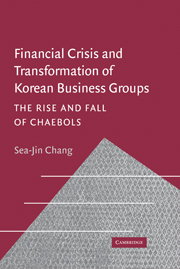Book contents
- Frontmatter
- Contents
- Preface
- 1 Introduction
- 2 The Evolution of Chaebols
- 3 Chaebols' Diversified Business Structure
- 4 Vertical Integration of Chaebols
- 5 The Capital Structure of Chaebols
- 6 Chaebols' Ownership and Governance Structure
- 7 The Restructuring of Chaebols
- 8 Conclusion
- Appendixes
- 1 Data Used in this Book
- 2 Comparing the Profitability of Group-affiliated Companies and Independent Companies
- 3 Profitability of Group-affiliated Firms
- 4 The Impact of Vertical Integration in Chaebols
- 5 Determinants of the Capital Structure of Chaebols
- 6 Profitability and Stock Ownership of Affiliates
- 7 Intragroup Business Transactions and Ownership Structures of the Top Five Chaebols
- 8 Key Economic Statistics
- Notes
- References
- Index
3 - Profitability of Group-affiliated Firms
Published online by Cambridge University Press: 05 January 2010
- Frontmatter
- Contents
- Preface
- 1 Introduction
- 2 The Evolution of Chaebols
- 3 Chaebols' Diversified Business Structure
- 4 Vertical Integration of Chaebols
- 5 The Capital Structure of Chaebols
- 6 Chaebols' Ownership and Governance Structure
- 7 The Restructuring of Chaebols
- 8 Conclusion
- Appendixes
- 1 Data Used in this Book
- 2 Comparing the Profitability of Group-affiliated Companies and Independent Companies
- 3 Profitability of Group-affiliated Firms
- 4 The Impact of Vertical Integration in Chaebols
- 5 Determinants of the Capital Structure of Chaebols
- 6 Profitability and Stock Ownership of Affiliates
- 7 Intragroup Business Transactions and Ownership Structures of the Top Five Chaebols
- 8 Key Economic Statistics
- Notes
- References
- Index
Summary
Appendix 2 showed that group-affiliated firms performed worse than independent firms did, especially during the late 1980s. This result may indicate that group affiliates diverted their profits by either subsidizing poorly performing affiliates or investing in group-level projects. This appendix focus on how group affiliation may positively affect firm performance by enabling affiliates to share resources with each other. The resource-based theory emphasizes the role of corporatewide resource sharing in building competitive advantage. Corporate strategy, according to Andrews (1980), “defines the business in which a company will compete, preferably in a way that focuses resources to convert distinctive competence into corporate advantage” (pp. 18–19). Prahalad and Hamel (1990) argue that corporate strategy and structure significantly and positively influence firm performance. This view is consistent with Porter (1987), who argues that corporate strategists can create value by transferring skills and sharing rent-generating activities among individual business units.
In Korea, chaebol affiliates freely share intangible resources with their affiliates, as we discuss in chapter 3. Kim (1996) illustrated how group-level R&D activities were the sources of competitive advantage in several leading industries such as automobiles, electronics, and semiconductors. Chaebols typically set up group-level R&D centers organized along broadly defined business areas such as electronics or automobiles. Several affiliates, including both final assemblers and parts suppliers, finance their joint R&D efforts. They share any technological innovations from these efforts to an extent that is not necessarily proportional to their contributions. They also transfer key personnel to facilitate further the sharing of technological resources.
- Type
- Chapter
- Information
- Financial Crisis and Transformation of Korean Business GroupsThe Rise and Fall of Chaebols, pp. 264 - 274Publisher: Cambridge University PressPrint publication year: 2003

